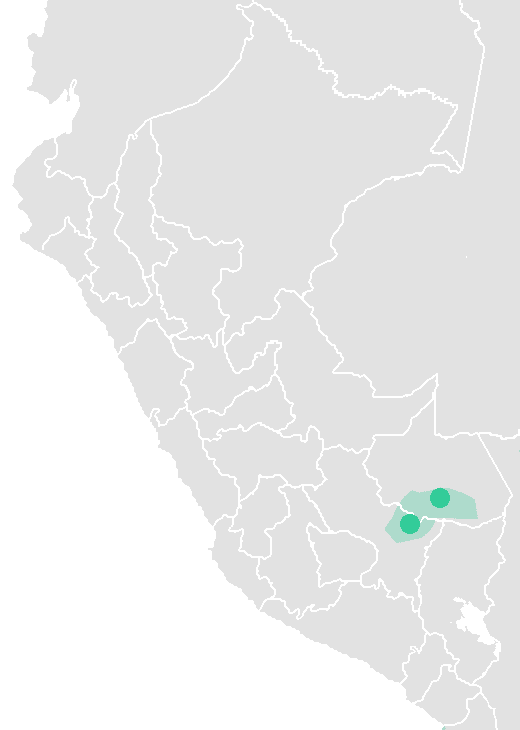|
Macro-Arawakan Languages
Macro-Arawakan is a proposed language family of South America and the Caribbean centered on the Arawakan languages. Sometimes, the proposal is called Arawakan, and the central family is called ''Maipurean''. Proposals Kaufman (1990) includes the following: *Arawakan (Maipurean) * Arawan *Guajiboan *Candoshi Payne (1991) and Derbyshire (1992) have: *Arawakan (Maipurean) * Arawan *Guajiboan *Puquina * Harakmbet Jolkesky (2016) argues for the following: *Arawakan (Maipurean) *Candoshi *Puquina * Munichi According to Jolkesky (op. cit., 611-616), the proto-Macro-Arawakan language would have been spoken in the Middle Ucayali River Basin during the beginning of the 2nd millennium BCE, and its speakers would have produced Tutishcainyo pottery in the region. Martins (2005: 342–370) groups the Arawakan and Nadahup languages The Naduhup languages, also known as Makú (Macú) or ''Vaupés–Japurá'', form a small language family in Brazil, Colombia, and Venezuela. The name '' M ... [...More Info...] [...Related Items...] OR: [Wikipedia] [Google] [Baidu] |
Latin America
Latin America or * french: Amérique Latine, link=no * ht, Amerik Latin, link=no * pt, América Latina, link=no, name=a, sometimes referred to as LatAm is a large cultural region in the Americas where Romance languages — languages derived from Latin — are predominantly spoken. The term was coined in the nineteenth century, to refer to regions in the Americas that were ruled by the Spanish, Portuguese and French empires. The term does not have a precise definition, but it is "commonly used to describe South America, Central America, Mexico, and the islands of the Caribbean." In a narrow sense, it refers to Spanish America plus Brazil (Portuguese America). The term "Latin America" is broader than categories such as ''Hispanic America'', which specifically refers to Spanish-speaking countries; and ''Ibero-America'', which specifically refers to both Spanish and Portuguese-speaking countries while leaving French and British excolonies aside. The term ''Latin America'' was f ... [...More Info...] [...Related Items...] OR: [Wikipedia] [Google] [Baidu] |
Ucayali River
The Ucayali River ( es, Río Ucayali, ) is the main headstream of the Amazon River. It rises about north of Lake Titicaca, in the Arequipa region of Peru and becomes the Amazon at the confluence of the Marañón close to Nauta city. The city of Pucallpa is located on the banks of the Ucayali. Description The Ucayali, together with the Apurímac River, the Ene River and the Tambo River, is today considered the main headwater of the ''Amazon River'', totaling a length of from the source of the ''Apurímac'' at Nevado Mismi to the confluence of the Ucayali and Marañón Rivers: *Apurímac River (total length): *Ene River (total length): *Tambo River (total length): * Ucayali River (confluence with Tambo River to confluence with the Marañón): Exploration The Ucayali was first called ''San Miguel'', then ''Ucayali'', ''Ucayare'', ''Poro'', ''Apu-Poro'', ''Cocama'' and ''Rio de Cuzco''. Peru has organised many costly and ably-conducted expeditions to explore it. One of the ... [...More Info...] [...Related Items...] OR: [Wikipedia] [Google] [Baidu] |
Daniel Garrison Brinton
Daniel Garrison Brinton (May 13, 1837July 31, 1899) was an American surgeon, historian, archaeologist and ethnologist. Biography Brinton was born in Thornbury Township, Chester County, Pennsylvania. After graduating from Yale University in 1858, Brinton studied at Jefferson Medical College for two years and spent the next year travelling in Europe. He continued his studies at Paris and Heidelberg. From 1862 to 1865, during the American Civil War, he was a surgeon in the Union army, acting during 1864–1865 as surgeon-in-charge of the U.S. Army general hospital at Quincy, Illinois. Brinton was sun-stroked at Missionary Ridge ( Third Battle of Chattanooga) and was never again able to travel in very hot weathers. This handicap affected his career as an ethnologist. After the war, Brinton practiced medicine in West Chester, Pennsylvania for several years; was the editor of a weekly periodical, the Medical and Surgical Reporter, in Philadelphia from 1874 to 1887; became professor of ... [...More Info...] [...Related Items...] OR: [Wikipedia] [Google] [Baidu] |
Aguachile Language
Lapachu, also known as Apolista or Aguachile, is an extinct Arawakan language of Bolivia. Aikhenvald (1999) classifies it together with Terena language, Terena, Moxos language, Moxos, and related languages. It is not clear from surviving descriptions whether it was one language or two. References Arawakan languages {{Arawakan-lang-stub pms:Lenga enawené-nawé Languages of Bolivia ... [...More Info...] [...Related Items...] OR: [Wikipedia] [Google] [Baidu] |
Yanesha' Language
Yanesha' (Yaneshac̈h/Yanešač̣; literally 'we the people'), also called Amuesha or Amoesha is a language spoken by the Amuesha people of Peru in central and eastern Pasco Region. Due to the influence and domination of the Inca Empire, Yanesha' has many loanwords from Quechua, including some core vocabulary. Yanesha' may also have been influenced by Quechua's vowel system so that, today, it has a three-vowel system rather than a four-vowel one that is typical of related Arawakan languages. There are also many loanwords from Kampa languages. Phonology Yanesha' has 26 consonants and 9 vowel phonemes. The consonants have a certain degree of allophonic variation while that of the vowels is more considerable. Consonants #The affricates and are phonetically aspirated # is an allophone of before Yanesha', similar to languages like Russian, Irish, and Marshallese, makes contrasts between certain pairs of palatalized and plain consonants: * ''anap̃'' ('he answered him') ... [...More Info...] [...Related Items...] OR: [Wikipedia] [Google] [Baidu] |
Moscow School Of Comparative Linguistics
The Moscow School of Comparative Linguistics (also called the Nostratic School) is a school of linguistics based in Moscow, Russia that is known for its work in . Formerly based at Moscow State University, it is currently centered at the (Institute of Linguistics of the Russian State University for the Humanities), and also the Institute of Linguistics of the Russian Academy of Sciences in Moscow, Russia. History The founders of the school are Vladislav Illich-Svitych and Aharon Dolgopolsky.Stachowski, Marek. Teoria nostratyczna i szkoła moskiewska (польск.) // LingVaria / Redaktor naczelny Mirosław Skarżyński. — Kraków: Wydawnictwo „Księgarnia Akademicka”, 2011. — T. VI, nr 1 (11). — S. 241—274. — ISSN 1896-2122.Старостин Г. С. и др. К истокам языкового разнообразия. Десять бесед о сравнительно-историческом языкознании с Е. Я. Сатановским. — Мос ... [...More Info...] [...Related Items...] OR: [Wikipedia] [Google] [Baidu] |
Purus River
The Purus River (Portuguese: ''Rio Purus''; Spanish: ''Río Purús'') is a tributary of the Amazon River in South America. Its drainage basin is , and the mean annual discharge is . The river shares its name with the Alto Purús National Park and the Purús Province (and its conformed Purús District), one of the four provinces of Peru in the Ucayali Region. Geography The Purus River rises in Peru. It defines the boundary between Peru and Brazil in the centre of the state of Acre, then runs for a short distance along the boundary of the Santa Rosa do Purus National Forest, a sustainable use conservation unit created in 2001 after it is joined by the Santa Rosa River. It then flows north east through Manoel Urbano It runs through a continuous forest at the bottom of the great depression, lying between the Madeira River, which skirts the edge of the Brazilian sandstone plateau, and the Ucayali River, which hugs the base of the Andes. In the state of Amazonas the river runs th ... [...More Info...] [...Related Items...] OR: [Wikipedia] [Google] [Baidu] |
Juruá River
The Juruá River (Portuguese ''Rio Juruá''; Spanish ''Río Yuruá'') is a southern affluent river of the Amazon River west of the Purus River, sharing with this the bottom of the immense inland Amazon depression, and having all the characteristics of the Purus as regards curvature, sluggishness and general features of the low, half-flooded forest country it traverses. For most of its length the river flows through the Purus várzea ecoregion. This is surrounded by the Juruá-Purus moist forests ecoregion. It rises among the Ucayali highlands, and is navigable and unobstructed for a distance of above its junction with the Amazon. It has a total length of approximately , and is one of the longest tributaries of the Amazon. The Médio Juruá Extractive Reserve, created in 1997, is on the left bank of the river as it meanders in a generally northeast direction through the municipality of Carauari. The lower Juruá River forms the western boundary of the Baixo Juruá Extractive Re ... [...More Info...] [...Related Items...] OR: [Wikipedia] [Google] [Baidu] |
Nadahup Languages
The Naduhup languages, also known as Makú (Macú) or ''Vaupés–Japurá'', form a small language family in Brazil, Colombia, and Venezuela. The name '' Makú'' is pejorative, being derived from an Arawakan word meaning "without speech". ''Nadahup'' is an acronym of the constituent languages. The Nadahup family should not be confused with several other languages which go by the name '' Makú''. There are proposals linking this unclassified language with Nadahup, but also with other languages. External relationships Martins (2005: 342–370) groups the Arawakan and Nadahup languages together as part of a proposed Makúan-Arawakan (Nadahup-Arawakan) family, but this proposal has been rejected by Aikhenvald (2006: 237). Epps and Bolaños (2017) accept the unity of the four Nadahup languages, but do not consider Puinave to be related. Language contact Jolkesky (2016) notes that there are lexical similarities with the Arawa, Guahibo, and Tupi language families due to contac ... [...More Info...] [...Related Items...] OR: [Wikipedia] [Google] [Baidu] |
Munichi Language
Munichi is a recently extinct language which was spoken in the village of Munichis, about 10 miles (16 km) west of Yurimaguas, Loreto Region, Peru. In 1988, there were two mother-tongue speakers, but they had not met since the 1970s. The last known fluent speaker, Victoria Huancho Icahuate, died in the late 1990s. As of 2009 there were several semi-speakers who retained significant lexical, and partial grammatical, knowledge of the language (Michael et al. 2013). It is also called ''Balsapuertiño'', named after the village of Balsapuerto in the department of Loreto, Peru. Word order in Munichi is VSO. Other varieties Unattested "Munichi stock" varieties listed by Loukotka (1968): *Tabaloso - spoken in Loreto department in the village of Tabalosa on the Mayo River *Chasutino (Cascoasoa) - once spoken in the village of Chasuta on the Huallaga River; now only Quechua is spoken. *Huatama (Otanavi) - once spoken in the villages of San José de Sisa and Otanahui in the same ... [...More Info...] [...Related Items...] OR: [Wikipedia] [Google] [Baidu] |
Arawakan Languages
Arawakan (''Arahuacan, Maipuran Arawakan, "mainstream" Arawakan, Arawakan proper''), also known as Maipurean (also ''Maipuran, Maipureano, Maipúre''), is a language family that developed among ancient indigenous peoples in South America. Branches migrated to Central America and the Greater Antilles in the Caribbean and the Atlantic, including what is now the Bahamas. Almost all present-day South American countries are known to have been home to speakers of Arawakan languages, the exceptions being Ecuador, Uruguay, and Chile. Maipurean may be related to other language families in a hypothetical Macro-Arawakan stock. Name The name ''Maipure'' was given to the family by Filippo S. Gilij in 1782, after the Maipure language of Venezuela, which he used as a basis of his comparisons. It was renamed after the culturally more important Arawak language a century later. The term ''Arawak'' took over, until its use was extended by North American scholars to the broader Macro-Arawakan ... [...More Info...] [...Related Items...] OR: [Wikipedia] [Google] [Baidu] |
Harakmbet Languages
The Harakmbut (Arakmbut, Harakmbet) are indigenous people in Peru. They speak the Harakmbut language. An estimated 2,000 Harakmbut people live in the Madre de Dios Region near the Brazilian border in the Peruvian Amazon."Peru: Indigenous Harakmbut Suffer Effects Of Climate Change." ''Indigenous Peoples Issues and Resources.'' (retrieved 20 Feb 2011) Amarakaeri  Amarakaeri are also called Amaracaire or Amarakaire people. Subg ...
Amarakaeri are also called Amaracaire or Amarakaire people. Subg ...
[...More Info...] [...Related Items...] OR: [Wikipedia] [Google] [Baidu] |

